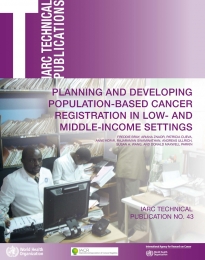
978-92-832-0435-0
978-92-832-0436-7
978-92-832-0437-4
This guidance document consists of six chapters that provide technical advice to planners and health specialists in low- and middle-income countries wishing to implement and develop population-based cancer registries (PBCRs) as information systems that inform cancer control policy. Chapter 1 places the need for cancer registration in the context of the rapidly increasing burden from the disease seen worldwide. Chapter 2 describes the characteristics of the different types of cancer registry and the unique functions of PBCRs and their present status worldwide. Chapters 3 and 4 outline the critical steps in planning and developing a PBCR in lower-resource settings, including discussion of the key sources of information required and the minimal standard set of data items that the PBCR should collect. Aspects in the set-up that will help ensure the sustainability of the registry are emphasized, including comments on infrastructure and resource requirements as well as the commitment of stakeholders. Chapter 5 describes the main techniques to evaluate and further enhance the data quality at the PBCR. Chapter 6 provides some advice on reporting the results to the community at large in support of cancer control and thus promoting the increasing utility of the registry.
Cover Page
Table of contents
Contributors
Acknowledgements, Foreword, Preface, Executive summary, Abbreviations
Chapter 1 – Introduction
Chapter 2 – The role and status of population-based cancer registration
Chapter 3 – Planning and developing a population-based cancer registry
Chapter 4 – Sources of information for the population-based cancer registry
Chapter 5 – Quality control at the population-based cancer registry
Chapter 6 – Making the population-based cancer registry heard – reporting the results
References – References
Annex 1. – CanReg5
Annex 2. – Selected data quality indicators by country or region
List of corrections